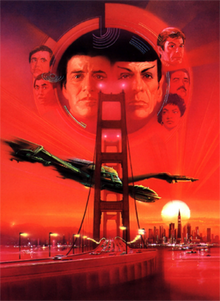
Back Star Trek IV: The Voyage Home AN ستار تريك 4: رحلة العودة للوطن Arabic Зорны шлях IV: Вандраванне дадому Byelorussian Зорны шлях: Вандраваньне дадому BE-X-OLD Стар Трек IV: Пътуване към вкъщи Bulgarian Star Trek 4: Missió salvar la Terra Catalan Star Trek IV: Cesta domů Czech Star Trek IV: The Voyage Home Welsh Star Trek IV - Rejsen tilbage til Jorden Danish Star Trek IV: Zurück in die Gegenwart German
| Star Trek IV: The Voyage Home | |
|---|---|
 Theatrical release poster art by Bob Peak | |
| Directed by | Leonard Nimoy |
| Screenplay by | |
| Story by |
|
| Based on | Star Trek by Gene Roddenberry |
| Produced by | Harve Bennett |
| Starring | |
| Cinematography | Donald Peterman |
| Edited by | Peter E. Berger |
| Music by | Leonard Rosenman |
Production company | |
| Distributed by | Paramount Pictures |
Release date |
|
Running time | 122 minutes[1] |
| Country | United States |
| Language | English |
| Budget | $26 million[2] |
| Box office | $133 million[3] |
Star Trek IV: The Voyage Home is a 1986 American science fiction film, the fourth installment in the Star Trek film franchise based on the television series Star Trek. The second film directed by Leonard Nimoy, it completes the story arc begun in Star Trek II: The Wrath of Khan (1982), and continued in Star Trek III: The Search for Spock (1984). Intent on returning home to Earth to face trial for their actions in the previous film, the former crew of the USS Enterprise finds the planet in grave danger from an alien probe attempting to contact now-extinct humpback whales. The crew travel to Earth's past to find whales who can answer the probe's call.
After directing The Search for Spock, Nimoy was asked to direct the next feature, and given greater freedom regarding the film's content. Nimoy and producer Harve Bennett conceived a story with an environmental message and no clear-cut villain. Dissatisfied with the first screenplay produced by Steve Meerson and Peter Krikes, Paramount hired The Wrath of Khan writer and director Nicholas Meyer. Meyer and Bennett divided the story between them and wrote different parts of the script, requiring approval from Nimoy, lead actor William Shatner, and executives at Paramount Pictures.
Principal photography commenced on February 24, 1986. Unlike previous Star Trek films, The Voyage Home was shot extensively on location, with many real settings and buildings used as stand-ins for scenes set around and in the city of San Francisco. Special effects firm Industrial Light & Magic assisted in post-production and the film's special effects. Few of the humpback whales in the film were real. ILM devised full-size animatronics and small motorized models to stand in for the real creatures. The film was dedicated to the crew of the Space Shuttle Challenger, which broke up 73 seconds after takeoff on the morning of January 28, 1986.
The Voyage Home was released on November 26, 1986, in North America by Paramount Pictures, and became the top-grossing film at the weekend box office. The film's humor, acting, direction, special effects and unconventional story were well received by critics, fans of the series, and the general audience. It was financially successful, grossing $133 million worldwide, and earned several awards and four Academy Award nominations for cinematography and sound. It was followed by Star Trek V: The Final Frontier in 1989.
- ^ "Star Trek IV - The Voyage Home (PG)". British Board of Film Classification. March 10, 1987. Archived from the original on June 17, 2013. Retrieved May 22, 2013.
- ^ Nimoy, Leonard (1992). Star Trek IV: The Voyage Home - Director's Series (VHS). Paramount Pictures.
- ^ Eller, Claudia (December 11, 1998). "Lower Costs Energize 'Trek' Film Profits". Los Angeles Times. Archived from the original on November 18, 2020. Retrieved May 21, 2020.